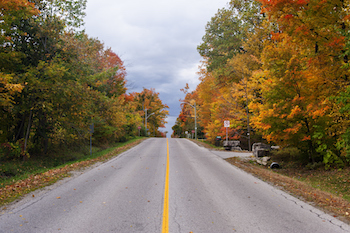 The long days of summer are well and truly over. They’ve been replaced by cold mornings, scattered leaves and a sun that drops ever lower in the sky. But whilst autumn may be a beautiful season of frosty walks and blackberry crumbles, it can also be a hazardous season on the roads. By following these ten simple tips, you can make your driving much safer this autumn.
The long days of summer are well and truly over. They’ve been replaced by cold mornings, scattered leaves and a sun that drops ever lower in the sky. But whilst autumn may be a beautiful season of frosty walks and blackberry crumbles, it can also be a hazardous season on the roads. By following these ten simple tips, you can make your driving much safer this autumn.
- Don’t forget to put your headlights on.
- Remember that wet leaves are a skid hazard. Approach them as carefully as you would a patch of water; slow down before, don’t accelerate over them and be aware of possible hidden hazards underneath, like potholes.
- It’s essential to check your tyres for tread depth, condition and pressure. 3mm is the minimum tread to aim for. It may not be time for ice on the roads yet, but they will still be slippery during autumn and good quality tyres help to prevent accidents.
- Allow time in the cold mornings for your car to warm up and for condensation to be dispelled. Always make sure that you have maximum visibility before you begin to drive. But remember not to leave your car unattended.
- Check that your fog lights are working. Autumnal mornings often bring patches of dense fog, especially in rural areas.
- If your car battery is over three years old, you should have it checked by a qualified mechanic, so visit a reputable garage near you. There’s nothing worse on a cold morning when you need to get to work than a car that won’t start.
- Low sunlight in the autumn months can be dazzling for drivers. Make sure that your windscreen is clean inside and out to reduce any glare and drive carefully when it’s sunny.
- Consider replacing your windscreen wipers as you head into winter, especially if they’re more than two years old. Worn wipers don’t work effectively and can make dazzling glare much worse. You should also check your washer fluid levels. Refer to the car handbook to make sure that you’re filling the right reservoir and add fluid designed for the purpose for maximum efficiency.
- Check all the bulbs on your car at least once a week, especially headlights and brake lights. It’s also useful to carry spare bulbs. Driving in the dark without adequate lights can be a criminal offence.
- Ensure that your spare tyre if you have one is in a good and usable condition.
- We recommend that you keep an emergency kit in the car in case of breakdowns. In addition to the standard car repair kit, you should make sure that you carry:
> A fluorescent jacket so you can be seen in dark weather
> A fluorescent triangle to alert other motorists (place this some yards away from your car)
> A torch
> Gloves and a warm hat
> Water
> A phone charger
Autumn is a wonderful season and driving through the UK countryside is one of the best ways to enjoy it. Just make sure that your car is in good working order and that you are prepared should anything happen.



